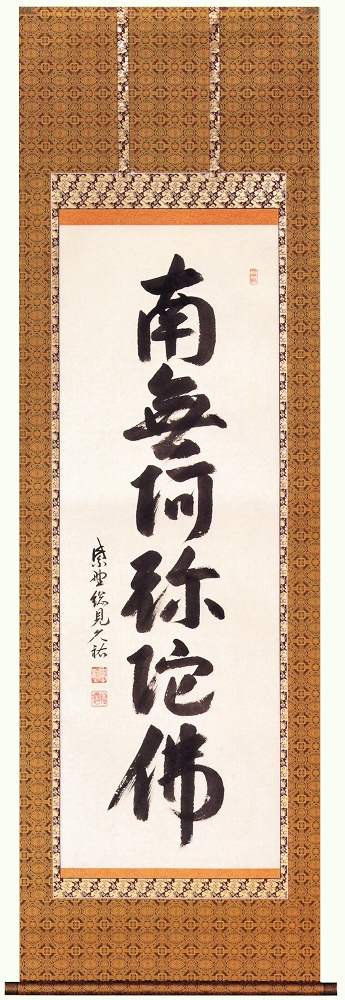Jodo Shu
In Japan, Pure Land Buddhism was established, as a sect, in 1175 by Honen (1133-1212), who taught that even those who had mastered Buddhist philosophy “should behave themselves like simpleminded folk” and devote themselves in practicing the Nembutsu, recitation of the formula Namu Amida Butsu [homage to Amitabha Buddha]. This concept of Honen is known as ‘Jodo Shu’.
Jodo Shu traces its history back to the moment in 1175 when the teacher Honen set up residence on Higashiyama and began his teaching career. While this is perhaps best understood as a mythical beginning for Jodo Shu, a more complicated beginning was developed by Honen’s disciples through several streams according to their own epistemology so this 1175 is the most trustworthy.
Although all of these movements consider Honen as a mentor and legendary teacher, it is only Jodo Shu which claims him as its principal teacher and which attempts to carry on his essential teaching. It was not until the early 15th century that the teachings and training system of Jodo Shu was systematized and that it gained official government approval. This was soon followed by a period of great prosperity inaugurated by the patronization of Tokugawa Ieyasu in 1590. From this prosperity to the excesses of the late Edo period and through the second world war period, Jodo Shu has proceeded to develop and change.

Today, Jodo Shu has about seven thousand temples and Chion-in, in Kyoto, is considered to be the head temple. There are seven other main temples in the country and nineteen oversea temples in Hawaii, mainland USA and Brazil. The number of Jodo Shu adherents, in japan, in 2001 was 6.5 million.
Honen came across a Chinese commentary which said, “Only repeat the name of Amitabha [Amida] with all your heart, whether walking or standing, whether sitting or lying; never cease to practice for a moment. This is the very work which unfailingly issues in salvation.” Following this statement Honen took up the practice of repeating the Nembutsu 60,000 times a day eventually increasing that to 70,000 times a day. From there on, as the heart of all rituals as practiced by the Jodo School has been Nembutsu (literally means “Buddha in mind”).
 In Jodo Shu, they recite the Nembutsu at three different occasions. The first type of recitation is done in every day’s life, and is called “Jinjo Gyogi”. The second type of Nembutsu is called “Betsuji Nembutsu” which is performed only on a pre-determined date and time, according to a calendar. The third type is called “Rinju Gyogi” and chanted on one’s deathbed just before the believer is welcomed into the Pure Land (Jodo in Japanese.)
In Jodo Shu, they recite the Nembutsu at three different occasions. The first type of recitation is done in every day’s life, and is called “Jinjo Gyogi”. The second type of Nembutsu is called “Betsuji Nembutsu” which is performed only on a pre-determined date and time, according to a calendar. The third type is called “Rinju Gyogi” and chanted on one’s deathbed just before the believer is welcomed into the Pure Land (Jodo in Japanese.)
There are three different ways of reciting the . First, ‘Junen’ prescribes to recite ‘Namu Amida Butsu’ ten times. Secondly, ‘Nembutsu Ichie’ suggests reciting as many times as possible without limiting its number. Thirdly, ‘Sanshorai’ proposes to recite three times very slowly and finished with a deep bow. This is repeated three times making nine, the total number of Nembutsu.
Nembutsu is the 18th vow out of a series of 48 vows that Amitabha Buddha made in the ‘Larger Sutra of Immeasurable Life’.
The Five theories of Nembutsu are as follow:
“Faith is a primary element in the efficacy of Nembutsu, but not an exclusive one”- Nembutsu relates the limited self and the Unlimited, the Unborn, the Deathless.
“Contrition is a necessary preparation for Nembutsu”: Contrition is the softening of heart comes through confession that one is a foolish being of wayward passion and so is in the same plight spiritually as others. It is the foremost important pre-requisite of awakening through uttering the Nembutsu meaningfully.
“Good work springs naturally from Nembutsu”: When one utter with the utmost belief,” I, a foolish being, ask You to act through me”, he conquers freedom from the blindness of superiority and finds pleasure in service to mankind.
“Nembutsu is a condensed form of all of Buddha’s teaching”: Nembutsu is a concise expression of all the essence of the teachings of Buddha.
“Nembutsu brings us into the presence of the sacred”: It abandons one’s life to Buddha and expresses a willingness to rely upon the calling from the other shore.
Besides Nembutsu, Jodo Shu encourage followers to engage in ‘auxiliary’ practices, such as observing the Five Precepts, meditation, the chanting of sutras and other good conduct.
In Tokyo, Japan, a Jodo Shu Research Institute has been established in 1989 through the integration of three separate institutes on Jodo Shu teachings: propagation and rituals which had been established 50 years earlier. In present day, a number of books are available some of them follow:
|
‘Traversing the Pure Land Path: A Lifetime of Encounters with Honen Shonin ‘A Raft from the Other Shore : Honen and the Way of Pure Land Buddhism ‘Disciples of the Buddha |
Jodo Shu followers celebrate several Ceremonies that include shusho-e, Gyoki-e, nehan-e, Chinzeiki, Zendoki, Spring season Higan-e, Founder’s Day/Honen’s Birthday (shuso-kotan-e), Buddha’s Birthday (kanbutsu-e), Segaki-e May to September, Kishuki, Urabon-e, Autumn season Higan-e, Buddha’s Enlightenment (jodo-e), Chanting of the Buddhas’ Names (butsumyo-e), Joya.
Jodo Shu allows its believers to experience deep tranquility and the silence of peace when one abandons his/her ego, reflects on how ignorant and sinful he/she was as a human being, and leave everything to the compassion of Amida Buddha, reciting Namu Amida Butsu many times.
|
Return from Jodo Shu to Schools of Japanese Buddhism |

New! Comments
Have your say about what you just read! Leave me a comment in the box below.